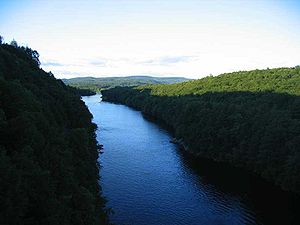Celebrating water protection in N.E.
A stretch of the Connecticut River in western Massachusetts.
BOSTON
At a spot overlooking Boston Harbor, once choked with toxic pollution but now home to some of the cleanest urban beaches in the United States, advocates gathered July 1 to thank the Obama administration for closing loopholes in the Clean Water Act that previously left more than half of Massachusetts’s streams at risk of pollution.
“We’ve made so much progress in cleaning up our waterways, and we can’t afford to turn back the clock,” said Ben Hellerstein, state director for Environment Massachusetts. “The EPA’s Clean Water Rule will make a big difference in protecting Boston Harbor, the Charles River and all of the waterways we love.”
The Clean Water Rule, finalized in late May, clarifies federal protections for waterways following confusion over jurisdiction created by Supreme Court decisions in 2001 and 2006. It restores Clean Water Act protections to thousands of miles of streams that feed into waterways that provide drinking water for millions.
“In New England, protecting our water is more important than ever, especially as we work to adapt to climate-change impacts such as sea-level rise and stronger storms,” Environmental Protection Agency (EPA) Regional Administrator Curt Spalding said. “Protecting the most vulnerable streams and wetlands — a drinking-water resource for one in three Americans — helps our communities, and this rule provides clarity for businesses and industry without creating new permitting requirements.”
Before the Clean Water Rule became law, small streams, headwaters and certain wetlands were in a perilous legal limbo, allowing polluters and developers to dump into them or destroy them in many cases without a permit. In a four-year period following the rule’s creation, the EPA had to drop more than 1,500 cases against polluters, according to one analysis by The New York Times.
Prior to the passage of the Clean Water Act in 1972, Massachusetts waterways suffered from decades of pollution and neglect. As late as the 1980s, untreated sewage was regularly dumped into Boston Harbor, and high concentrations of industrial pollutants posed a public-health risk.
The Clean Water Act prompted a major cleanup of the harbor. Today, Boston boasts some of the cleanest urban beaches in the nation, and wildlife habitat has significantly improved, according to Environment Massachusetts.
Advocates pointed out that the Clean Water Act has enabled similar improvements in water quality in many of the state’s most iconic waterways, from the Charles River to the Connecticut River.
Despite broad public support for clean-water protections, polluting industries and some members of Congress are fighting to block implementation of the Clean Water Rule. In recent weeks, congressional committees have approved multiple bills aimed at rolling back the Clean Water Rule.
